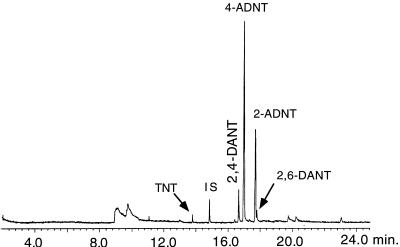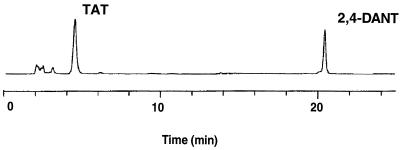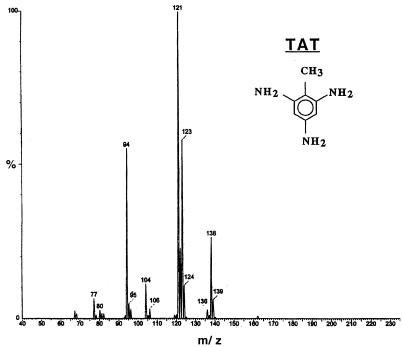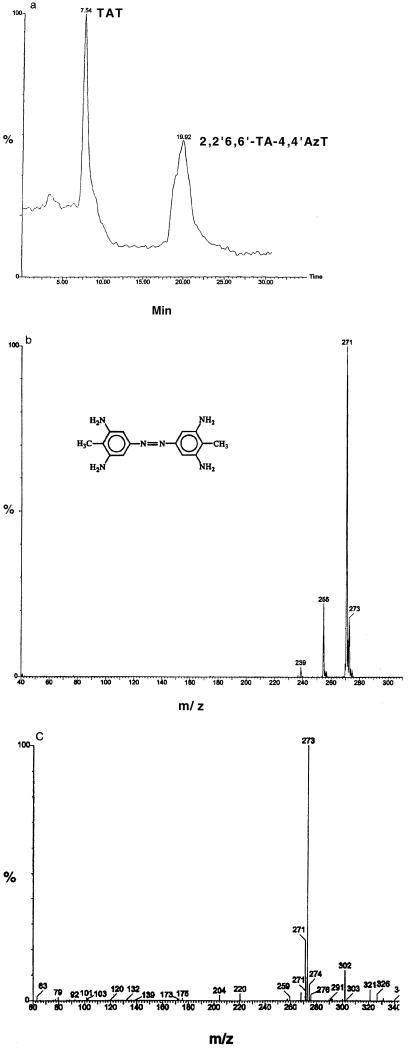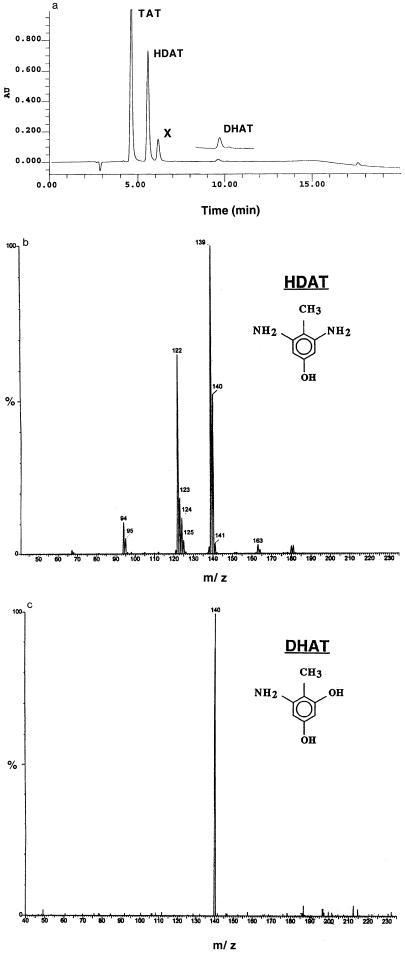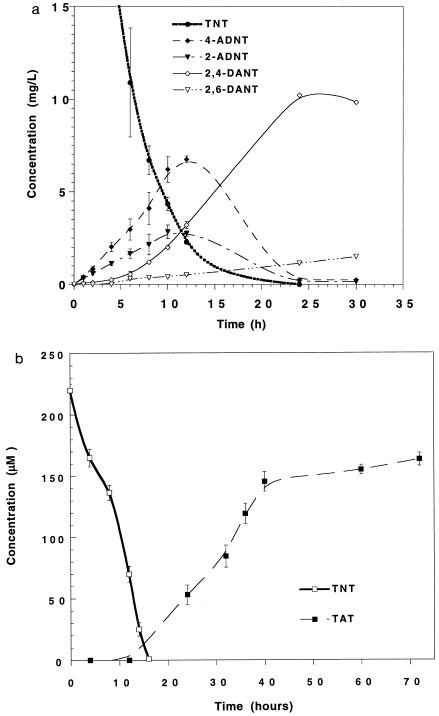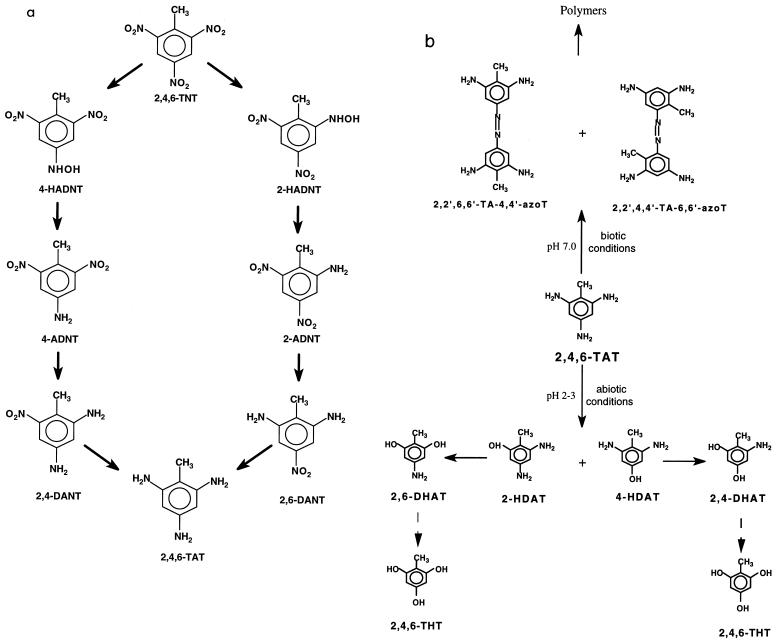Abstract
The present study describes the biotransformation of 2,4,6-trinitrotoluene (TNT) (220 μM) by using anaerobic sludge (10%, vol/vol) supplemented with molasses (3.3 g/liter). Despite the disappearance of TNT in less than 15 h, roughly 0.1% of TNT was attributed to mineralization (14CO2). A combination of solid-phase microextraction–gas chromatography-mass spectrometry and liquid chromatography-mass spectrometry identified two distinctive cycles in the degradation of TNT. One cycle was responsible for the stepwise reduction of TNT to eventually produce triaminotoluene (TAT) in relatively high yield (160 μM). The other cycle involved TAT and was responsible for the production of azo derivatives, e.g., 2,2′,4,4′-tetraamino-6,6′-azotoluene (2,2′,4,4′-TA-6,6′-azoT) and 2,2′,6,6′-tetraamino-4,4′-azotoluene (2,2′,6,6′-TA-4,4′-azoT) at pH 7.2. These azo compounds were also detected when TAT was treated with the anaerobic sludge but not with an autoclaved sludge, suggesting the biotic nature of their formation. When the anaerobic conditions in the TAT-containing culture medium were removed by aeration and/or acidification (pH 3), the corresponding phenolic compounds, e.g., hydroxy-diaminotoluenes and dihydroxy-aminotoluenes, were observed at room temperature. Trihydroxytoluene was detected only after heating TAT in water at 100°C. When 13CH3-labeled TNT was used as the N source in the above microcosms, we were unable to detect 13C-labeled p-cresol or [13CH3]toluene, indicating the absence of denitration or deamination in the biodegradation process. The formation and disappearance of TAT were not accompanied by mineralization, suggesting that TAT acted as a dead-end metabolite.
Presently, contamination of soils by highly energetic chemicals such as 2,4,6-trinitrotoluene (TNT), generated as waste from the munitions and defense industries, is a significant worldwide environmental problem. These compounds are mutagenic and toxic and have the tendency to persist in the environment (27, 30, 33). It is estimated that TNT alone is produced in amounts close to 2 million pounds a year (11) and threatens human life through the food chain (33). There have been several attempts to degrade TNT, most preferably by biological means, but thus far the compound has been found to undergo biotransformation rather than mineralization (3, 5, 7, 9, 19, 28, 29). In almost all studied cases the initial products from TNT degradation are the reduced amino derivatives, such as 4-NH2-2,6-di-NO2-toluene (4-ADNT), 2-NH2-4,6-di-NO2-toluene (2-ADNT), 2,4-di-NH2-6-NO2-toluene (2,4-DANT), and 2,6-di-NH2-4-NO2-toluene (2,6-DANT) (6, 13). Under strictly anaerobic conditions these amine derivatives transform into 2,4,6-triaminotoluene (TAT) (8, 9, 17, 20, 25). Most literature reports that the exact role of TAT during TNT biodegradation is not yet clear and warrants further investigation (14, 17, 24).
One objective of the present study is to investigate all possible steps involved in the biodegradation of TNT leading to the formation of TAT under anaerobic conditions and to investigate the fate of TAT and its implication on the mineralization process. This requires extensive product analysis of all relevant intermediates, including short-lived ones, directly in the culture medium and before they undergo further transformations. The frequently applied traditional liquid-liquid extraction followed by chromatography cleanup and analysis is not always suitable for the detection of such transient metabolites. Missing a metabolite in a biotransformation process may also lead to the loss of a valuable piece of information on the metabolic pathway.
In the present study a combination of two powerful analytical techniques, namely solid-phase microextraction (SPME)–gas chromatography-mass spectrometry (SPME–GC-MS) and liquid chromatography-mass spectrometry (LC-MS), will be applied to analyze intermediates formed during TNT biodegradation with anaerobic sludge. SPME uses a polymer-coated fiber for the adsorption of organic compounds from the aqueous-phase sample followed by direct thermal desorption of the analytes in the injection port of a GC. The technique is known for its speed and sensitivity, which enables detection in the micrograms/liter range (2, 22, 22a, 23). On the other hand, LC-MS allows for the direct injection of the aqueous culture medium into the MS detector for metabolite determination. The applicability of the two techniques to determine key metabolites in the biodegradation of TNT with anaerobic sludge will be evaluated. A time study of the appearance and disappearance of the detected TNT metabolites will be used to elucidate the biotransformation pathway of TNT and the reasons behind its poor mineralization despite its unique reactivity.
MATERIALS AND METHODS
Reagents and solutions.
TNT was obtained from Defence Research Establishment Valcartier (Quebec, Canada), and 2-ADNT, 4-ADNT, 2,4-DANT, and 2,6-DANT were purchased from AccuStandard Inc. (New Haven, Conn.). Methylphloroglucinol (2,4,6-trihydroxytoluene) was purchased from Spectrum Chemicals (New Brunswick, N.J.), and a technical grade (about 95% pure) of 2,4,6-triaminotoluene · hydrochloride (TAT · 3HCl) was obtained from Chemservice (Westchester, Pa.). Uniformly labeled [U-14C]TNT and [13CH3]TNT were synthesized as described by Ampleman et al. (1). The sludge was obtained from a food factory located in the city of Cornwall, Ontario, Canada. BBL dry anaerobic indicator (VWR; Canlab, Ontario, Canada) was used to detect air leaks and to insure anaerobic conditions.
Microcosm description for the degradation of TNT.
In a typical setup, a serum bottle (100 ml) was charged with deionized water (34 ml), anaerobic sludge (5 ml), a mineral salt medium (1 ml) composed of 2.0 g of KH2PO4 per liter, 3.0 g of K2HPO4 per liter, 30 g of NaHCO3 per liter, 35 g of KHCO3 per liter, and 30 g of Na2SO4 per liter. Molasses (3.3 g/liter) served as a carbon source and TNT (50 mg/liter) as the N source for the degrading microorganisms. Some serum bottles (microcosms) were supplemented with a uniformly labeled [U-14C]TNT (100,000 dpm) and then fitted with a small test tube containing 1.0 ml of 0.5 M KOH to trap liberated carbon dioxide (14CO2) (10). The headspace in each microcosm was flushed with nitrogen gas to maintain anaerobic conditions and then sealed with butyl rubber septa and aluminum crimp seals to prevent the loss of CO2 and other volatile metabolites. The absence of air in these microcosms was monitored by using special indicators called BBL dry anaerobic indicators (VWR; Canlab). Two control microcosms were prepared: one contained the sludge without TNT and the second contained TNT and an autoclaved sludge. Each microcosm was wrapped with aluminum foil to protect the mixture against photolysis. Microcosms with [U-14C]TNT were routinely sampled (daily or every 2 days) for the determination of 14CO2 in the KOH trap by using a Packard Tri-Carb 4530 liquid scintillation counter (Model 2100 TR; Packard Instrument Company, Meriden, Conn.). In some experiments, 13CH3-labeled TNT was used as the N source to confirm the presence or absence of certain TNT biotransformed products such as p-cresol and toluene. Microcosms that did not receive 14C-labeled TNT were reserved for SPME–GC-MS, high-pressure liquid chromatography (HPLC)-UV and LC-MS analysis of residual TNT and its metabolites (see below). Each microcosm was carried out in triplicate.
SPME–GC-MS monitoring of TNT biotransformation.
Briefly, fused silica capillary fibers (1 cm) coated with either 85 μm of polyacrylate or 100 μm of polymethylsiloxane fitted to an autosampler assembly were used (Supelco, Bellfonte, Pa.). The fiber was conditioned by placing it inside the injection port of a GC-MS at 300°C (ca. 2 h). Subsequently, aliquots (1 ml) from the TNT culture medium were spiked with the recovery standard 4-ethyl-dibenzylthiopene (4-Et-DBT; 250 ppb) and filtered through a Millex-HV 0.45-μm-pore-size filter to remove suspended material including biomass. A 20-min adsorption time from the aqueous solution followed by a 10-min desorption inside the GC injector were found appropriate for reproducible analyses. A GC (Varian 3400) fitted with a DB-5 column (30 by 0.25 by 0.25 μm thick) by using He as a carrier gas was used. Oven initial temperature was 90°C (2 min), increased to 165°C (10°C/min), and then incremented to 250°C (5°C/min). Mass analysis was carried out with a Varian Saturn II system in the El mode (70 eV) by using a mass range of 15 to 300 amu, a background mass of 14 amu, and a mass scan rate equal to 0.5 s/scan. A time study to monitor the formation and disappearance of metabolites was carried out at t = 0 and at hourly intervals for the first 10 h of the experiment, followed by 5 h of sampling events until 30 h and, finally, daily sampling until the end of the experiment.
HPLC analysis (EPA method 8330).
Aliquots (1 ml) from the above treated culture medium were mixed with 1 ml of acetonitrile, filtered, and analyzed by using a Waters HPLC system fitted with a Waters pump (Waters Chromatography Division, Milford, Mass.) and connected to a WISP auto injector (Model 710b; Millipore). Samples (50 μl) from the culture medium were injected into a Supelco C8 column (25 cm by 4.6 mm; particle size, 5 μm) coupled with a Temperature Control Module (model TCM; Millipore) by using a mobile phase composed of a water-isopropanol mixture (82:18, vol/vol). A programmable UV-VIS multiwavelength detector (Model 490; Millipore) was used for quantification at λ 254 nm. Quantification was done by using external standards composed of known concentrations of TNT, 2-ADNT, 4-ADNT, 2,6-DANT, and 2,4-DANT. TAT was analyzed at 219 nm by using ion pairing on a C18 column with octanesulfonic acid as the ion-pairing agent. A time study, with the same profile described for the SPME, was conducted for purposes of conformity and comparison.
LC-MS.
LC-MS to identify and verify TNT metabolites was performed on a Micromass Platform II benchtop single quadrupole mass detector fronted by a Hewlett Packard 1100 Series HPLC system. Analyte ionization was either done in the positive atmospheric pressure chemical ionization mode (APCI+) using a cone voltage of 30 V and a source temperature of 150°C or by negative electron spray ionization (ES−) at 30 V and 90°C. Chromatography was in an ion-pairing mode with a C18 column (25 cm by 4.6 mm; 5-μm particles) and octanesulfonic acid as the ion-pairing agent. The flow rate was 1 ml/min with a postcolumn split of 5:95. A cross-flow counter electrode scheme was used to prevent salt components in the mobile phase from entering the detector.
Analysis of nitrite and ammonium ions.
The aqueous layer was analyzed for NO2− ions with an SP 8100 HPLC with a 25- by 0.46-cm PRP-X 100 Hamilton column and a Waters 431 conductivity detector. Methanol (10%) buffered (pH 8.5) with a solution of p-hydroxybenzoic acid was used as mobile phase at a flow rate of 2 ml/min. Analytical-grade sodium nitrite was used as the standard. Ammonium ions were analyzed by using the same system but with a PRP-X 200 Hamilton column with 30% MeOH in 6 mM nitric acid solution at a flow rate of 0.75 ml/min.
RESULTS AND DISCUSSION
Metabolite identification.
The SPME–GC-MS chromatogram shown in Fig. 1 summarizes TNT biotransformation after 12 h of incubation with the anaerobic sludge. All intermediates in Fig. 1 were identified by comparison with their corresponding standards using retention times (rt), molecular mass ions (M/z), and base peak mass ions (bp). The parameters (rt [minutes], M/z [amu], and bp [amu]) for the four detected intermediates were as follows: for 2-ADNT, 17.70, 197, and 180; for 4-ADNT, 16.98, 197, and 180; for 2,4-DANT, 16.66, 167, and 167; and for 2,6-DANT, 17.82, 167, and 167, respectively.
FIG. 1.
SPME–GC-MS total ion chromatogram of TNT after 12 h of treatment with an anaerobic sludge taken from a baby food factory. IS, internal standard.
Another set of metabolites, with much shorter lifetimes than those detected above, were observed after 6 to 8 h of incubation. Their identities were confirmed by using ES− at 30-V LC-MS. Two isomeric metabolites with the same molecular ion of 213 amu were observed and attributed as being 2-hydroxylamino-4,6-dinitrotoluene (2-HADNT) and 4-hydroxylamino-2,6-dinitrotoluene (4-HADNT) by comparison with reference materials. Both 2-HADNT and 4-HADNT are prerequisites for the formation of the corresponding amine derivatives 2-ADNT and 4-ADNT, respectively.
Due to its high polarity and solubility in water, TAT was not detected by SPME–GC-MS, and furthermore, it eluted with the void volume in the case of HPLC (method no. 8330). The presence of TAT was finally confirmed by ion-pairing HPLC by using octanesulfonic acid as an ion-pairing agent and a C18 column (Fig. 2). The triamine metabolite, TAT, appearing after 12 h of TNT incubation, was identified by comparison with a standard and by APCI+ and LC-MS (M+H; 138 amu) as shown in Fig. 3. TAT was detected in very high concentrations (160 μM), accounting for 73% of the initial concentration of TNT (220 μM). The pH inside the microcosms under these conditions ranged from 6.5 to 7.2.
FIG. 2.
HPLC chromatogram of the same culture medium used in producing Fig. 1, but in this case, analysis was carried out by using a C18 column with octanesulfonic acid as an ion-pairing agent.
FIG. 3.
The LC-MS spectrum of TAT obtained with a Micromass Platform II mass detector by using APCI+ at 30 V. Injection was carried out with an HP 1100 Series HPLC system by using a C18 column (25 cm by 4.6 mm; 5-μm particles) with octanesulfonic acid as the ion-pairing agent.
TAT was accumulated in the system for 6 days but gradually disappeared and produced a new set of products including the azo derivatives 2,2′,4,4′-tetraamino-6,6′-azotoluene (2,2′,4,4′-TA-6,6′-azoT) and 2,2′,6,6′-tetraamino-4,4′-azotoluene (2,2′,6,6′-TA-4,4′-azoT). Figure 4a is the LC-MS ion chromatogram of the anaerobic culture medium showing TAT together with its azo derivatives, whereas Fig. 4b represents the mass chromatogram showing the molecular mass ion (M+H; 271 amu) for a detected isomeric azo isomer, presumed to be 2,2′,6,6′-TA-4,4′-azoT. When using TAT instead of TNT as an N source (pH 7.2) for the degrading microorganisms in the sludge we obtained the two isomeric azo derivatives with the same LC-MS molecular mass ions (M+H; 271 amu). However, if the sludge was autoclaved before use, no azo compounds were observed. These results confirmed that the detected azo compounds were biotic products.
FIG. 4.
(a) LC-MS total ion chromatogram of TAT and several of its overlapped azo derivatives after 6 days of incubation under anaerobic conditions. (b) A typical LC-MS spectrum of the suggested para azo isomer of TAT as obtained by using APCI+ at 30 V. (c) A typical LC-MS spectrum of the suggested 13C-para azo isomer of TAT (2,2′,6,6′-TA-4,4′-azoT) obtained using 13CH3-TNT as the N substrate and APCI+ at 30 V.
Furthermore, with 13CH3-labeled TNT we obtained LC-MS spectra whose molecular mass ions were 2 amu higher than those obtained from the unlabeled TNT (Fig. 4c). Several other LC-MS peaks with higher-molecular-mass ions, e.g., 537 amu identified as a TAT azo tetramer, were also detected, suggesting that these azo compounds might have been formed as intermediates during TAT polymerization to polyazo compounds.
Interestingly, oxidized azo dimers are known to be recalcitrant under aerobic conditions but with a tendency to cleave to form the corresponding amines anaerobically (4, 16, 26). It is possible that traces of some metal ions in the sludge might have triggered the oxidation of TAT through an e-transfer process (16), justifying the formation of oxidized azo products under anaerobic conditions. Earlier the microbial conversion of TAT by sulfidegenic isolate to ammonium ion and unidentified products has been reported to be catalyzed by Mn2+ under aerobic conditions (25). No gas leak was suspected in the present experiments, because the microcosms were sealed under a bed of nitrogen and monitored with a dry anaerobic indicator. However, oxidation is an electron transfer process that does not necessarily involve reaction with oxygen. We speculate that an anonymous reduction in the bioprocess might have triggered TAT oxidation to produce the azo derivatives.
No hydrolyzed phenolic products from TAT were observed while the microcosms stayed strictly anaerobic and near neutral (pH 7.2). After 2 h of exposure to air, TAT disappeared gradually to produce two products (Fig. 5a) that were tentatively identified by LC-MS as the phenolic products hydroxy-diaminotoluenes (HDAT) (M+H; 139 amu) and dihydroxy-aminotoluenes (DHAT) (M+H; 140 amu) (Fig. 5b and c). No trihydroxytoluene (THT) was observed under these conditions. The absence of hydrolyzed TAT products under anaerobic conditions (pH 7.2) might indicate that TAT biotransformation to the corresponding azo compounds was faster than its rate of hydrolysis at this buffered pH. For example, we found that TAT hydrolysis to THT occurred after heating the triamine in water at 100°C (32).
FIG. 5.
(a) HPLC chromatogram of 2,4,6-TAT and its hydrolyzed phenolic products HDAT and DHAT obtained by exposing the microcosms treating TNT with anaerobic sludge to air at pH 2. X, unidentified product. Analysis was carried out by using a C18 column with octanesulfonic acid as an ion-pairing agent. (b) The mass spectrum of TAT phenolic product HDAT as obtained by using APCI+ at 30 V, and (c) the mass spectrum of TAT phenolic product DHAT as obtained using positive APCI+ at 30 V.
When air was allowed inside freshly prepared anaerobic microcosms with TAT (40 ppm) rather than TNT as the N source, the triamine concentration diminished without producing the azo compounds. Instead, the two phenolic products HDAT and DHAT were detected, whose rate of formation increased under acidic conditions (pH 2 to 3). On the other hand, when TAT (40 ppm) was treated with a buffered autoclaved sludge (pH 7.0) under nitrogen, neither phenolic nor azo compounds were observed for more than 2 days. In the presence of air, TAT started to disappear without giving appreciable amounts of phenolic compounds for more than 24 h. After acidification to pH 2 to 3, TAT disappeared in less than 3 h, and both phenolic products HDAT and DHAT were detected together with a trace amount of THT.
18O labeling confirmed that water rather than oxygen was the source of the hydroxyl groups in these hydrolyzed TAT products, indicating that aeration was not directly involved in the conversion of TAT to the phenolic derivatives. Instead, oxygen in suppressing the anaerobic microbial activity inside the microcosm might have opened the way for the slower TAT hydrolysis to take place at neutral conditions (pH 7). As we mentioned earlier, TAT hydrolysis can be enhanced by acidification (pH 2 to 3) and/or heating with water. Acidic conditions (pH < 6) have been shown to enhance the decomposition of TAT, although no products were identified (25). Eventually the presence of oxygen led to the decomposition of TAT phenolic intermediates to unidentified products, which is in line with the use of phenols as antioxidants.
Naumova et al. (21) reported the formation of 2,4,6-trihydroxybenzene (THB), known as phloroglucinol, in a culture medium treating TNT under anaerobic conditions. Funk et al. (9), however, reported the observation of THT and suggested that Naumova’s metabolite was THT and not THB. They also suggested that THT is a rearranged species of TAT and both are present in an equilibrated fashion. Later, Lewis et al. (18) reported that anaerobic treatment of TNT with Clostridium bifermentans produced as end products TAT and the phenolic compounds of TAT hydrolysis. In our case, no TAT phenolic products were detected in the microcosms treating TNT under anaerobic conditions (pH 7.2). To say the least, to be able to observe the disputed THT, the TAT metabolite must be hydrolyzed either under severe acidic conditions (pH 2) or at an elevated temperature (100°C).
No proof on the presence of either para-cresol or toluene as metabolite was evident, since the sludge itself was found to contain p-cresol (10 ppm) and traces of toluene. However, preliminary data showed that when a [13CH3]TNT was treated with the sludge neither [13CH3]toluene nor [p-13CH3]cresol was detected. For example, the formation of such intermediates would necessitate the elimination of a nitro group from TNT or an amine from its corresponding amino intermediates, but neither ion was detected under anaerobic conditions.
Both para-cresol (9) and toluene (3) have been reported as metabolites during TNT biotransformation under anaerobic conditions. In their study, Boopathy and Kupla (3) found that when TNT is used as a sole N source for a sulfate-reducing bacterium (Desulfovibrio sp.), it produces toluene after transforming the substrate into TAT. The authors reported that 45 days were needed to accumulate detectable amounts of the intermediate. In the present study, neither denitrated nor deaminated toluenes were detected after more than 60 days of incubation. There is a lot of controversy surrounding the denitration of TNT. In a more recent article, Vorbeck et al. (29) reported on the absence of TNT reductive denitration by Rhodococcus erythropolis strain HL PM-1, although monohydride and dihydride Meisenheimer complexes were formed.
Reduced denitrated TNT intermediates have been reported earlier by Duque et al. (7) by using a constructed Pseudomonas hybrid strain and TNT as N and C sources. Interestingly, it has been found that batches of TNT used in our study contain traces of 2,4-dinitrotoluene (2,4-DNT) which upon reduction could produce 2,4-DANT. The contamination of TNT with 2,4-DNT can thus be easily misinterpreted as a denitrated or deaminated TNT metabolite. Also, neither the o-dihydroxy nor the p-dihydroxy toluene derivatives, both considered to be prerequisites to the cleavage of the aromatic ring prior to mineralization (20), were observed.
Mechanistic considerations: the role of TAT.
An SPME–GC-MS time study for the disappearance of TNT and the appearance and disappearance of its metabolites is shown in Fig. 6a. Whereas TNT disappeared rapidly, in less than 15 h, its amine metabolites 4-ADNT, 2-ADNT, 2,4-DANT, and 2,6-DANT formed in a stepwise and regioselective fashion favoring reduction of the NO2 group at the para- position over that at the ortho- one. For example, during the first 15 h of incubation the ratios of 4-ADNT/2-ADNT and 2,4-DANT/2,6-DANT were 2.0 and 6.0, respectively. After 20 h, both 2-ADNT and 4-ADNT disappeared, and the product ratio 2,4-DANT/2,6-DANT increased from 6 to more than 10. Stepwise reduction of polynitro aromatics under both biotic and abiotic conditions have been reported earlier but with varying degrees of regioselectivities (12, 20, 21, 31). Preuß et al. (24) reported that the reduction of 2,4-DANT is the rate-limiting step in the overall reduction process of TNT.
FIG. 6.
(a) A time study of 2,4,6-TNT biotransformation as observed by SPME–GC-MS. (b) A time study of 2,4,6-TNT disappearance together with the formation of 2,4,6-TAT as observed by HPLC with a C18 column with octanesulfonic acid as an ion-pairing agent.
The disappearance of di-aminotoluenes 2,4-DANT and 2,6-DANT was accompanied by the accumulation of TAT (160 μM). Figure 6b signifies the relationship between the disappearance of TNT and the formation of TAT as determined by the HPLC ion-pairing technique. After 6 days of incubation under anaerobic conditions, TAT started to disappear, producing the TAT azo derivatives, e.g., 2,2′,4,4′-TA-6,6′-azoT and 2,2′,6,6′-TA-4,4′-azoT. After 30 days, TAT and its azo-derivatives disappeared, leaving behind an unidentified precipitate, possibly a polyazo compound, although the system was kept strictly anaerobic. As mentioned earlier, no TAT hydrolysis products (phenolics) were detected under anaerobic conditions. Only when the microcosms containing the TAT metabolite were exposed to air were the phenolic products HDAT, DHAT, and traces of THT formed. Eventually, TAT and its phenolic products disappeared to an unidentified precipitate (polymer). TAT is known to be a reactive molecule and would eventually react with itself if not with other hydroxylated compounds such as phenolics and carboxylic acids expected to be present in the sludge (8, 18, 25). Carpenter et al. (5) demonstrated that the biotransformation of 14C-labeled TNT in an activated sludge system leads to the formation of polyamide precipitate due to a reaction involving biotransformed TNT products with protein constituents of the microbial flora. All these transformations were taking place without causing any increase in mineralization. In all, about 0.1% of all disappeared 14C-labeled TNT was accounted for as due to mineralization (14CO2).
From the preceding discussion it seems that there were two distinctive biotic cycles that were taking place during TNT biodegradation with the anaerobic sludge. The first one was responsible for the transformation of TNT to TAT, whereas the other one led to the conversion of TAT to its azo derivatives, which apparently reacted further to produce azo polymers. In the presence of air, TAT underwent slow hydrolysis to the corresponding phenolics. The formation of these hydrolyzed products was enhanced under acidic conditions (pH 2). Eventually these phenolic products disappeared to produce unknown polymers, too.
The sequence of events deduced from the above detailed time study was eventually translated into the transformation pathways depicted in Fig. 7a and 7b. Most elements shown in Fig. 7a represent the biotic cycle of TNT biotransformation to TAT and have been frequently observed (13, 18, 24). The new elements that were uncovered in the present study included the provision of exclusive LC-MS analytical evidence on the subsequent biotransformation of TAT to the corresponding azo derivatives, e.g., 2,2′,4,4′-TA-6,6′-azoT and 2,2′,6,6′-TA-4,4′-azoT (Fig. 7b). Removing the anaerobic conditions by exposure to air or by acidification (pH 2), TAT was transformed into the phenolic derivatives HDAT and DHAT (Fig. 7b), which eventually disappeared and gave an unidentified precipitate (polymer?). This is not the first time that TAT was described as a killer metabolite that misrouted TNT from mineralization under anaerobic conditions (27). However, to take advantage of the rapid rearrangement of TNT to TAT, Knackmuss (15) recommended that a joint anaerobic-aerobic sequential process may be the best approach to successfully mineralize TNT.
FIG. 7.
(a) Constructed anaerobic cycle for the biotransformation of 2,4,6-TNT to 2,4,6-TAT with anaerobic sludge. (b) The subsequent transformations of 2,4,6-TAT to the corresponding azo derivatives at pH 7.0 and to the corresponding phenolic compounds at pH 2 to 3. Dashed arrows indicate that THT was formed in trace amounts at best, and its formation required heating in water at 100°C.
None of the transformation cycles explained in Fig. 7 were accompanied by mineralization (14CO2). Also, as we mentioned earlier, by using [13CH3]TNT as the N substrate we showed that neither [p-13CH3]cresol nor [13CH3]toluene was observed in the present study.
It is emphasized here that in establishing metabolic pathways, defined strains of microorganisms are normally employed to act on the target pollutant. In the present study, the sludge that was used is expected to contain an undefined cocktail of microorganisms and a complicated mixture of unidentified products.
One main conclusion from the present study is that TAT had no significant contribution to TNT mineralization. In contrast, it possibly acted as a dead-end product that misrouted TNT from mineralization. However, if the formation of TAT is still considered as an intermediary path to mineralization, then one might suspect that the rate must be very slow compared to its other side reactions, such as hydrolysis, polymerization, and condensation with other -OH- and -COOH-containing compounds. Obviously, more work is needed to exploit the practical significance of TAT involvement as a major biotransformed product during TNT biodegradation.
ACKNOWLEDGMENTS
We greatly appreciate the technical assistance of C. Beaulieu, S. Deschamps, and A. Corriveau. We also thank Peter Lau for bringing some relevant references to our attention and S. Guiot and C. F. Shen for providing us with the sludge.
Footnotes
This publication is issued as NRCC 41771.
REFERENCES
- 1.Ampleman G, Thiboutot S, Lavigne J, Marois A, Hawari J, Jones A J, Rho D. Synthesis of 14C-labeled RDX, TNT, NC and GAP for use in assessing the biodegradation potential of these energetic chemicals. J Label Compd Radiopharm. 1995;36(6):559–577. [Google Scholar]
- 2.Arthur C L, Pawliszyn J. Solid phase microextraction with thermal desorption using fused silica optical fibers. Anal Chem. 1990;62:2145–2148. [Google Scholar]
- 3.Boopathy R, Kupla C F. Nitroaromatic compounds serve as nitrogen source for Desulfovibrio sp. (B. strain) Can J Microbiol. 1993;34:430–433. doi: 10.1139/m93-062. [DOI] [PubMed] [Google Scholar]
- 4.Brown D, Hamburger B. The degradation of dyestuffs: part III. Investigation of their ultimate degradability. Chemosphere. 1987;16:1539–1553. [Google Scholar]
- 5.Carpenter D F, McCormick N G, Cornell J H, Kaplan A M. Microbial transformation of 14C-labeled 2,4,6-trinitrotoluene in an activated-sludge system. Appl Environ Microbiol. 1978;35:949–954. doi: 10.1128/aem.35.5.949-954.1978. [DOI] [PMC free article] [PubMed] [Google Scholar]
- 6.Crawford R L. Biodegradation of nitrated munition compounds and herbicides by obligately anaerobic bacteria. In: Spain J C, editor. Biodegradation of nitroaromatic compounds. New York, N.Y: Plenum Press; 1995. pp. 87–98. [Google Scholar]
- 7.Duque E, Haidour A, Godoy F, Ramos J L. Construction of a Pseudomonas hybrid strain that mineralizes 2,4,6-trinitrotoluene. J Bacteriol. 1993;175:2278–2283. doi: 10.1128/jb.175.8.2278-2283.1993. [DOI] [PMC free article] [PubMed] [Google Scholar]
- 8.Ederer M M, Lewis T A, Crawford R L. 2,4,6-Trinitrotoluene (TNT) transformation by clostridia isolated from a munition-fed bioreactor: comparison with non-adapted bacteria. J Ind Microbiol Biotechnol. 1997;18:82–88. doi: 10.1038/sj.jim.2900257. [DOI] [PubMed] [Google Scholar]
- 9.Funk S B, Roberts D J, Crawford D L, Crawford R L. Initial-phase optimization for bioremediation of munition compound-contaminated soils. Appl Environ Microbiol. 1993;59:2171–2177. doi: 10.1128/aem.59.7.2171-2177.1993. [DOI] [PMC free article] [PubMed] [Google Scholar]
- 10.Greer C W, Masson L, Commeau Y, Brousseau R, Samson R. Application of molecular biology techniques for isolating and monitoring pollutant-degrading bacteria. Water Pollut Res J Can. 1993;28:275–287. [Google Scholar]
- 11.Harter D R. The importance of nitroaromatic chemicals in the chemical industry. In: Ricket D E, editor. Toxicity of nitroaromatic chemicals. Chemical Industry Institute of Toxicology series. New York, N.Y: Hemisphere Publishing Corp.; 1985. pp. 1–14. [Google Scholar]
- 12.Kaplan D L. Biotransformation pathways of hazardous energetic organonitro compounds. In: Kamely D, Chhakrabarty A, Omenn G S, editors. Advances in applied biotechnology. 4. Biotechnology and biodegradation. Houston, Tex: Portfolio Publishing Co.; 1990. pp. 155–182. [Google Scholar]
- 13.Kaplan D L, Kaplan M A. Thermophilic biotransformation of 2,4,6-trinitrotoluene under simulated composting conditions. Appl Environ Microbiol. 1982;44:757–760. doi: 10.1128/aem.44.3.757-760.1982. [DOI] [PMC free article] [PubMed] [Google Scholar]
- 14.Khan T, Hughes R B. Anaerobic transformation of 2,4,6-TNT and related nitroaromatic compounds by Clostridium acetobutylicum. J Ind Microbiol Biotechnol. 1997;18:198–203. [Google Scholar]
- 15.Knackmuss H-J. Basic knowledge and perspectives of bioelimination of xenobiotic compounds. J Biotechnol. 1996;51:287–295. [Google Scholar]
- 16.Kumar G S. Azo functional polymers: functional group approach in macromolecular design. Lancaster, Pa: Technomic Publishing Co.; 1992. [Google Scholar]
- 17.Lewis A, Ederer M M, Crawford R L, Crawford D L. Microbial transformation of 2,4,6-trinitrotoluene J. Ind Microbiol Biotechnol. 1997;18:89–96. doi: 10.1038/sj.jim.2900257. [DOI] [PubMed] [Google Scholar]
- 18.Lewis T A, Goszczynski S, Crawford R L, Korus R A, Admassu W. Products of anaerobic 2,4,6-trinitrotoluene (TNT) transformation by Clostridium bifermentans. Appl Environ Microbiol. 1996;62:4669–4674. doi: 10.1128/aem.62.12.4669-4674.1996. [DOI] [PMC free article] [PubMed] [Google Scholar]
- 19.Manning J F, Jr, Boopathy R, Kupla C F. A laboratory study in support of the pilot demonstration of a biological soil slurry reactor. Report SFIM-AEC-TS-CR-94038. Argonne, Ill: Bioremediation Group, Environmental Research Division, Argonne National Laboratory; 1995. [Google Scholar]
- 20.McCormick N G, Florence E F, Hillel L. Microbial transformation of 2,4,6-trinitrotoluene and other nitroaromatic compounds. J Appl Microbiol. 1976;31:949–958. doi: 10.1128/aem.31.6.949-958.1976. [DOI] [PMC free article] [PubMed] [Google Scholar]
- 21.Naumova R P, Amerkhanova N N, Shaikhutdinov A. Study of the first stage of the conversion of trinitrotoluene. Prikl Biokhim Mikrobiol. 1979;15:45–50. [Google Scholar]
- 22.Pawliszyn J. New directions in sample preparation for analysis of organic compounds. Trends Anal Chem. 1995;14:113–122. [Google Scholar]
- 22a.Pawliszyn J. Solid phase microextraction: theory and practice. New York, N.Y: Wiley-VCH, Inc.; 1997. pp. 229–241. [Google Scholar]
- 23.Poerschmann J, Zhang Z, Kopinke F-D, Pawliszyn J. Solid phase microextraction for determining the distribution of chemicals in aqueous matrices. Anal Chem. 1997;69:597–600. [Google Scholar]
- 24.Preuß A, Rieger P-G. Anaerobic transformation of 2,4,6-trinitrotoluene and other nitroaromatic compounds. In: Spain J C, editor. Biodegradation of nitroaromatic compounds. New York, N.Y: Plenum Press; 1995. pp. 69–85. [Google Scholar]
- 25.Preuss A J, Fimpel J, Diekert G. Anaerobic transformation of 2,4,6-trinitrotoluene. Arch Microbiol. 1993;159:345–353. doi: 10.1007/BF00290917. [DOI] [PubMed] [Google Scholar]
- 26.Razo-Flores E, Luijten M, Donlon B A, Lettinga G, Field J A. Complete biodegradation of the azodisalicylate under anaerobic conditions. Environ Sci Technol. 1997;31:2098–2103. [Google Scholar]
- 27.Rieger P-G, Knackmuss H-J. Basic knowledge and perspectives on biodegradation of 2,4,6-trinitrotoluene and related nitroaromatic compounds in contaminated soil. In: Spain J C, editor. Biodegradation of nitroaromatic compounds. New York, N.Y: Plenum Press; 1995. pp. 1–18. [Google Scholar]
- 28.Stahl J D, Aust S D. Biodegradation of 2,4,6-trinitrotoluene by white rot fungus Phanerochaete chrysosporium. In: Spain J C, editor. Biodegradation of nitroaromatic compounds. New York, N.Y: Plenum Press; 1995. pp. 117–131. [Google Scholar]
- 29.Vorbeck C, Lenke H, Fischer P, Spain J C, Knackmuss H-J. Initial reductive reactions in aerobic microbial metabolism of 2,4,6-trinitrotoluene. Appl Environ Microbiol. 1998;64:246–252. doi: 10.1128/aem.64.1.246-252.1998. [DOI] [PMC free article] [PubMed] [Google Scholar]
- 30.Walker J E, Kaplan D L. Biological degradation of explosives and chemical agents. Biodegradation. 1992;3:369–385. [Google Scholar]
- 31.Weber E J, Elcovitz M S, Truhlar D G, Cramer J C, Barrows S E. Factors controlling regioselectivity in the reduction of polynitroaromatics in aqueous solution. Environ Sci Technol. 1996;30:3029–3038. [Google Scholar]
- 32.Weidel H. Über das Methylphloroglucin. Monatshefte Chem. 1898;19:223–235. [Google Scholar]
- 33.Won W D, Di Salvo L H, Ng J. Toxicity and mutagenicity of 2,4,6-trinitrotoluene and its microbial metabolites. Appl Environ Microbiol. 1976;31:575–580. doi: 10.1128/aem.31.4.576-580.1976. [DOI] [PMC free article] [PubMed] [Google Scholar]



